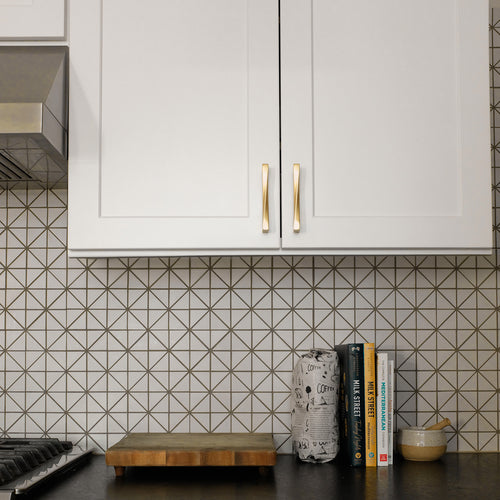The Importance of Balance
Understanding positioning and balance is key to creating the right kitchen aesthetic. With such a large budget typically going into a kitchen remodel, it's essential to ensure you have a foundational understanding of hardware for your kitchen drawer and cabinets.
Summary of the 1 / 3 Rule for Kitchen Handles
The summary is that it's typically where the pull length is about one-third the width of a drawer or cabinet door.
Quick Table for Rule of Thumb for Kitchen Cabinet Pulls
| Cabinet Type | Width Range | Recommended Pull Size (center to center) | Placement |
|---|---|---|---|
| Cabinets & Drawers | Less than 12 inches | 3-4 inches | Centered horizontally |
| 12-24 inches | 4-6 inches | ||
| Over 24 inches | 5-6 inches or longer |
Note: These are general guidelines. Pull sizes and placements can be adjusted based on personal preference and cabinet design.
Design Principle at Play with the 1 / 3 Rule
Visual Balance and Proportion
Humans are wired to find symmetry and proportion pleasing. The "1/3 Rule" aligns with the Golden Ratio (approximately 1:1.618) and similar proportional systems used in art and architecture for centuries. While not an exact match, one-third is a close, practical approximation that creates harmony. A pull that’s too small (say, 1/10 the width) looks insignificant and lost, while one that’s too large (like 3/4 the width) dominates and feels cluttered. One-third splits the difference, making the pull noticeable yet subordinate to the cabinet itself. For a 30-inch drawer, a 10-inch pull feels "right" because it divides the surface into manageable visual segments without overwhelming the eye.
Psychological Perception
Our brains process visual information by grouping elements. A pull that’s roughly one-third the width acts as a focal point without breaking the cabinet’s surface into jarring parts. Studies in visual cognition show we prefer designs where elements relate logically to the whole. A 10-inch pull on a 30-inch drawer creates two roughly equal "empty" thirds on either side, which feels balanced and intentional. If the pull were 20 inches, it’d crowd the space, making the drawer look busy or top-heavy.
Functional Ergonomics
Beyond looks, the pull’s size affects how it feels to use. A pull that’s one-third the width is long enough to grip comfortably. It typically spanning the average adult hand (about 3-4 inches for a relaxed grasp, but scalable for larger surfaces). On a 30-inch drawer, a 10-inch pull gives you room to wrap your fingers around it without fumbling, especially if the drawer is heavy or deep. For larger drawers (36 inches or more), two pulls or a longer single pull maintains this usability. If the pull’s too short, you’re pinching it awkwardly; too long, and it’s overkill for the force needed.
Historical Precedent
Cabinet hardware design evolved from utilitarian roots. Over time, craftspeople settled on proportions that worked practically and looked good. The one-third guideline echoes this tradition, refined through trial and error. It’s why antique furniture often feels timeless, the ratios weren’t random. Modern design keeps this because it’s a proven sweet spot.








